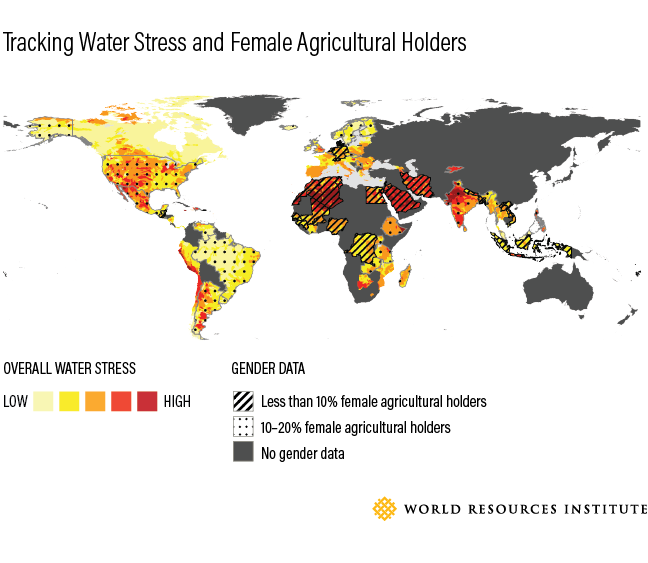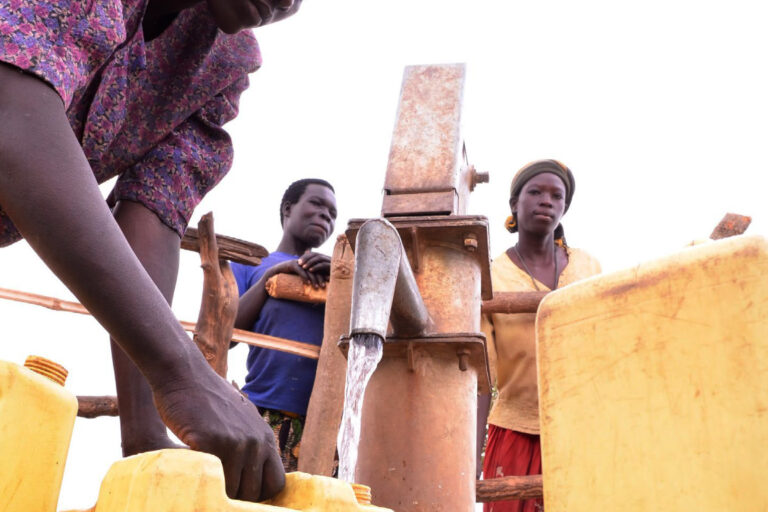
Women, Water and World Hunger
How addressing women’s burdens from water risks could help promote global food security.
For hundreds of millions of women, providing food to feed their families is a daily imperative. Many of them depend solely on the meager yields of small plots and farms, with little or no access to support when vital crops fail. At the same time, they shoulder the burden of household chores like fetching water, washing and cooking. For these reasons, water shortages and other threats to food security usually affect women far more than men, with ripple effects on socio-cultural, economic, ecological and political issues.
Last year at the fifth UN High Level Political Forum (HLPF) in New York, where progress on Sustainable Development Goals (SDGs) was reviewed, separate discussions on SDG 2 (zero hunger) and 5 (gender equality) may have fallen short in addressing the complexities of the food security-gender gap. The importance of the issue is underlined by statistics: women comprise, on average, 43 percent of the agricultural work force in developing countries, grow as much as 80 percent of all food consumed in Sub-Saharan Africa, and produce 50 percent of all staple crops in Asia. These numbers are, in fact, underestimated―if unpaid work was accounted for, the figures would be even higher.
Media reports from various regions elucidated the risks and challenges that women farmers face in times of water stress. In drought-stricken East Africa, women were forced to shoulder a ‘triple burden’–to survive, to care for their families, and to evade sexual violence as they travel farther distances in search of water. Zimbabwe’s alternating drought and flood conditions meant that female farmers lost a considerable proportion of their yield and were susceptible to domestic violence from male members of their household when harvests failed. In various South Asian countries, the climate-forced migration of male household members burdens women with additional farm labor; this stress is compounded by structural and social barriers to accessing male-centric extension services, which fail to provide information, inputs or technologies specific to women’s agricultural roles.
Women’s vulnerability to risks of changing weather patterns is even greater when they own no assets to hedge against these risks. Speaking on a panel on gender equality at the UN HLPF, Uganda’s Director of Gender and Community Development, Jane S. Mpagi, asserted that “access to, control over and ownership of productive resources such as land and credit” is a central issue in the feminization of poverty. In developing countries, only 10-20 percent of all land owners are women. Lack of female ownership of land, property and technology also translates into restricted access to finance and household decision-making and keeps them from moving in the direction of sustainable agriculture.
To understand where this double disadvantage is most pertinent for women, we compared global data on water stress using WRI’s Aqueduct water risk atlas with data on women’s agricultural holdings from FAO (Figure 1).

This figure highlights a few key challenges in the water-food-gender nexus:
- Many countries do not collect data on female agricultural holdings. This dearth of nationally collected, sex-disaggregated data leads to misidentification and underestimation of the gendered nature of this issue, causing it to be left out of discussions on water and food security.
- In most countries that do collect this data, less than 20 percent of all agricultural landholders are listed as female. Many North African and Asian countries report numbers less than 10 percent. However, this low figure is not indicative of women’s contribution to agriculture, as the latter regions are among the world’s highest in terms of overall female participation in the agricultural sector.
- In North Africa and Asia, where the vast majority of landholders are male, there is also high water stress. In these areas, women may be at a double disadvantage. With strong gender-norms regarding household labor, it is women who must travel farther for collection of water and face the consequences of lower agricultural productivity.
Participants in the UN discussions agreed that as countries forge ahead towards Agenda 2030―the plan of action to achieve the SDGs―there must be a shift in states’ siloed approaches towards gender equality. Collection of sex-disaggregated data, globally as well as locally, will help inform decision-makers on the unique effects water and food production risks have on women. When implementing new solutions for efficiently managing water resources or increasing yields, officials must act to ensure men and women alike are beneficiaries.
The potential payback is huge. If women had the same access to resources like land, water, agricultural inputs, finance, extension services, information and technology as men, they could increase yields by 20-30 percent. Empowering women in the agricultural sector could pull 100-150 million people out of hunger, making progress towards the SDGs aimed at eliminating hunger and advancing gender equality.
This post originally appeared on the World Resources Institute website.
Ayushi Trivedi is the Gender and Social Equity Research Analyst in WRI’s Governance Center. She focuses on the implementation of the gender and social equity strategy for all programs across the institute. She also supports programs for deep dive integration of gender and social equity in their projects, and has worked with the Forest and Water Programs for the same.
Natalie Elwell is the senior gender advisor, working to ensure that WRI’s programs, activities, and policies benefit women and men equally and contribute to gender equity. Natalie joins WRI from USAID where she served as the Senior Advisor for Gender and Environment, working to build capacity within the Agency to advance and leverage women’s empowerment and gender equality to enhance the outcomes of environment and climate change programming. Natalie also guided the team providing support for gender integration across technical portfolios, supported strategic planning for the office and agency level guidance and training for implementation of the Gender Equality and Female Empowerment policy.
Sara Walker is a Senior Manager for Water Quality and Agriculture in WRI’s Water Program. She leads the Institute’s global water quality work, including mapping and measuring eutrophication and advancing innovative policy approaches like water quality trading to cost-effectively reduce nutrient pollution. Sara also manages the Water Program’s work on identifying and mitigating water-related risks to and impacts of agricultural production.
Header photo by Bobby Neptune for Winrock International.
Related Projects

